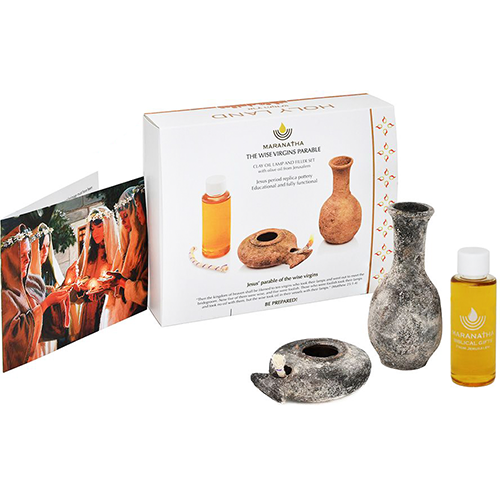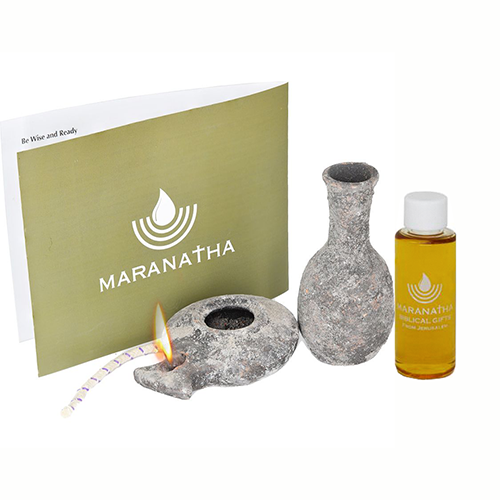Wise Virgins Clay Lamp, Filler & Oil Set - Jesus Period
Wise Virgins Clay Lamp, Filler & Oil Set - Jesus Period
SKU: SP158.1
Couldn't load pickup availability
This inspiring clay lamp set comes with a pamphlet describing Jesus' parable of the wise virgins. This is the type of oil lamp and filler that would have been used by Jesus and His disciples in Jerusalem.
Then the kingdom of heaven shall be likened to ten virgins who took their lamps and went out to meet the bridegroom.
(Matthew 25:1)
This is a fully functional clay lamp and filler set from the heart of Jerusalem.
Made in Israel
Additional Information
Additional Information
- Lamp size: 3.6" / 9 cm approx.
- Box size: 7.8" x 6.7" x 2.6" / 20 x 17 x 6 cm.
- Oil Jug (4.5" Tall)
- 50ml Olive oil from Jerusalem included
- Authentic ancient style finish.
- Biblical Presentation of the Parable pamphlet included.
- Fully functional and educational.
- Certificate of authenticity.
- Includes 2 wicks.
- Made in Israel.
How to use these lamps: Insert one of the supplied wicks into the small hole on the lamp. Leave about 1/2" / 1.25cm protruding from the lamp. Fill the lamp through the larger hole with olive oil till about half full. Allow 2 minutes for the wick to soak the oil a little... then just light the wick.
Note: Add a saucer under the lamp as seepage may occur.
Imported from Israel
Since the beginning of archaeological research in the Holy Land, experts have known that pottery that is found in a site is one of the best ways to date the layers they uncover. The way people made pottery changed over time, and those changes can help us understand the flow of history.
During the time of Jesus, pilgrims who traveled by foot to Jerusalem brought oil lamps with them and lit them in the temple. They would also bring fillers to keep the lamp burning as long as they could; they hoped to bring the light from the temple home with them as a reminder of the holy place they had visited.
These particular lamps can be distinguished by their unique design: the lamp itself was made without a nozzle, and the nozzle was later carved with a knife and attached to the lamp. They are therefore known as “knife-pared lamps.” They are also easy to distinguish from other lamps because they didn’t have much decoration; pilgrims didn’t worry about how the lamp looked, as long as they could carry the light with them.
Even to this day, archaeological sites all over the Holy Land have yielded Herodian oil lamps, particularly in the Galilee around the lake of Kinneret, the place where Jesus spent much of his adult life, and north in the Golan. The practice of bringing the lamp home with you on your pilgrimage must have been widespread.
Lamps such as these have been found in the archeological digs of the Golan Heights ancient city of Gamla. During the times of the Second Temple – Gamla was considered the capital of the Golan and was famous for its manufacturing of high-quality olive oil. Gamla remained as a fortification against the Romans, but after three attempted sieges, the Romans eventually managed to knock down three walls of the fortification and captured the Jewish inhabitants inside. The story of Gamla is both heroic and tragic, often referred to as the Masada of the North.
Readers of the New Testament will know these lamps from one of Jesus’s most remarkable parables: the story of the ten virgins. Five of these virgins kept their lamps burning. No doubt they kept their supply of oil close at hand. They were wise and ready. Five more began the night with their lamps lit but did not keep a supply of oil nearby, so by the time the bridegroom arrived their lamps had gone out. They were not wise or ready. The message of the parable is clear: be wise and ready. Jesus is coming soon.
Share






